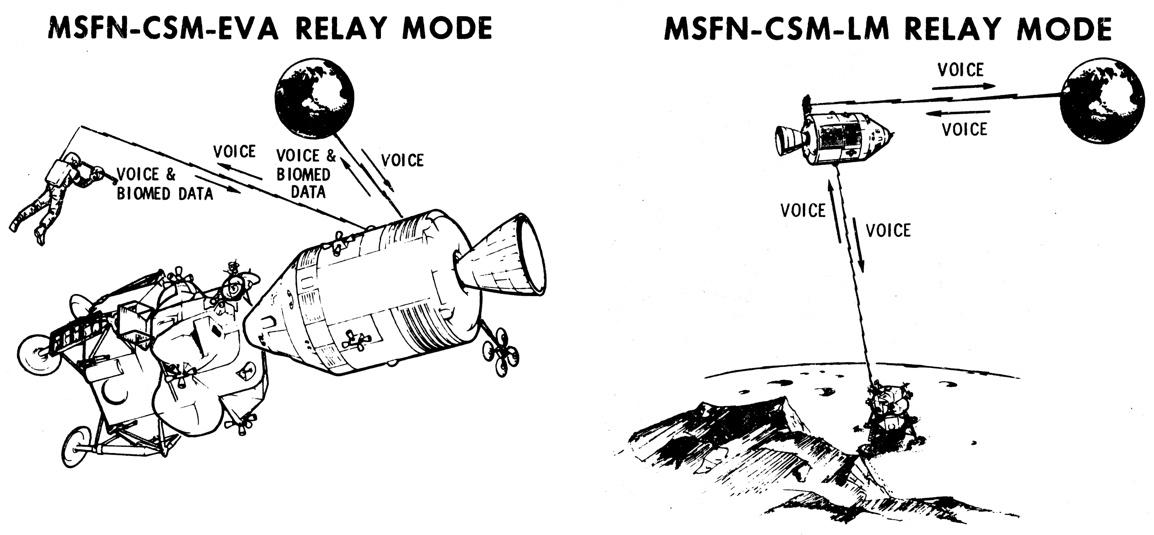Many thanks to SWLing Post contributor, Paul, who shares the following post from Ken Shirriffs’ Blog:
Reverse-engineering the Apollo spacecraft’s FM radio
How did NASA communicate with the Apollo astronauts, hundreds of thousands of miles from Earth? The premodulation processor1 (below) was the heart of the communication system onboard the Apollo spacecraft. Its multiple functions included an FM radio for communication to the astronauts, implemented by the Voice Detector, the module second from the top. In this blog post, I reverse-engineer the circuitry for that module and explain how it worked.
The Apollo communication system was complex and full of redundancy. Most communication took place over a high-frequency radio link that supported audio, telemetry, scientific data, and television images.2 NASA’s massive 85-foot dish antennas transmitted signals to the spacecraft at 2106.4 megahertz, an S-band frequency, giving the system the name “Unified S-Band”. These radio signals were encoded using phase modulation;3 onboard the spacecraft, a complex box called the transponder received the S-band signal and demodulated it.4
The voice and data signals from Earth were combined through a second layer of modulation: voice was frequency-modulated (FM) onto a 30-kilohertz subcarrier while data was on a 70-kilohertz subcarrier, so the two signals wouldn’t conflict.5 One of the tasks of the premodulation processor was to extract the voice and data signals from the transponder’s output. These voice signals went to yet another box, the Audio Center Equipment, so the astronauts could hear the messages from the ground. The data signals were decoded by the Up-Data Link, allowing NASA to send commands to the Apollo Guidance Computer, control onboard relays, or set the spacecraft’s clock.
Many systems worked together for communication, but I’m focusing on a single module: the voice detector inside the premodulation processor that performed the FM demodulation. [Continue reading the full article…]


One thing for sure, hot glue is fundamental for space exploration.
In 1968, CQ Magazine had a 2 part article about the Apollo communications system. Still relevant today, even if CQ is stingy about back issues.
One of the issues had a converter for about 240MHz by Frank C. Jones intended for receiving Apollo. But that turned out to not be useful.
In the June 1972 issue of QST, Dick Knadle and Paul Wilson had an article about how they independently received one of the Apollo missions. Fancy equipment, including parametric amplifiers, I think the last time Isaw them mentioned. This was at about 2400MHz.
Thomas, I tried to find the Contact page for your site, but was not able.
Just wanted to make sure you were aware of Maritime Radio Historical Society (MRHS) Night of Nights XXIII
https://www.radiomarine.org/
When: Opening transmission – 1701pdt12 July, 0001gmt 13 July
Stations & Frequencies:
KPH CW – 426, 500, 4247.0, 6477.5, 8642.0, 12808.5, 17016.8, 22477.5
KPH RTTY – 6324.5, 8427.0, 12585.5
KFS CW – 12695.5
K6KPH CW – 3550.0, 7050.0, 14050.0, 18097.5, 21050.0
Transmitters:
We are in the process of testing and tuning our classic transmitters from the 1950s.
MRHS Volunteer Transmitter Engineers will be working on swapping antennas over and ops checking the Vintage RCAs starting tomorrow Monday 11 July 2022
Hello John,
Just caught your post by accident. I’m just a run-of-the-mill swl, not a licensed amateur, but I was able to monitor your CW/RTTY transmissions on the following frequencies:
12808,17016, and 22477 kHz — KPH (CW)
12585 kHz — KPH (RTTY)
12695 kHz — KFS (CW)
3550, 7050, 14050, and 18096 kHz — K6KPH (CW)
My receiver was a Tecsun PL-880 with a Sangean ANT-60 with a long [7-m (~23-ft)] wire indoor antenna. My QTH is in SW Ohio; 2424 mi (3900 km) from your transmitters.
My thanks to you and your fellow MRHS volunteers for recreating Night of Nights XXIII. I certainly appreciated it.
73